Related Research Articles

A banshee is a female spirit in Irish folklore who heralds the death of a family member, usually by screaming, wailing, shrieking, or keening. Her name is connected to the mythologically important tumuli or "mounds" that dot the Irish countryside, which are known as síde in Old Irish.
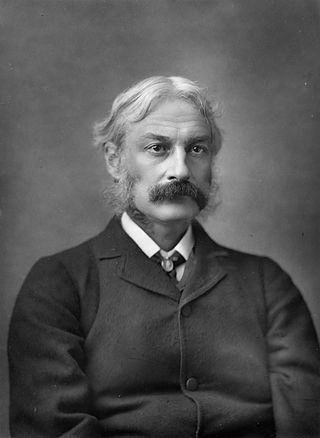
Andrew Lang was a Scottish poet, novelist, literary critic, and contributor to the field of anthropology. He is best known as a collector of folk and fairy tales. The Andrew Lang lectures at the University of St Andrews are named after him.
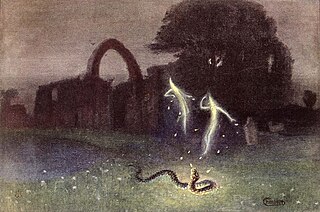
In folklore, a will-o'-the-wisp, will-o'-wisp, or ignis fatuus, is an atmospheric ghost light seen by travellers at night, especially over bogs, swamps or marshes. The phenomenon is known in much of European folklore by a variety of names, including jack-o'-lantern, friar's lantern, and hinkypunk, and is said to mislead travellers by resembling a flickering lamp or lantern. In literature, will-o'-the-wisp metaphorically refers to a hope or goal that leads one on, but is impossible to reach, or something one finds strange or sinister. Wills-o'-the-wisp appear in folk tales and traditional legends of numerous countries and cultures; notable named examples include St. Louis Light in Saskatchewan, the Spooklight in Southwestern Missouri and Northeastern Oklahoma, the Naga fireballs on the Mekong in Thailand, the Paulding Light in Upper Peninsula of Michigan, and the Hessdalen light in Norway.

A kelpie, or water kelpie, is a shape-shifting spirit inhabiting lochs in Irish and Scottish folklore. It is usually described as a grey or white horse-like creature, able to adopt human form. Some accounts state that the kelpie retains its hooves when appearing as a human, leading to its association with the Christian idea of Satan as alluded to by Robert Burns in his 1786 poem "Address to the Devil".
The redcap is a type of malevolent, murderous goblin found in Border folklore. He is said to inhabit ruined castles along the Anglo-Scottish border, especially those that were the scenes of tyranny or wicked deeds and is known for soaking his cap in the blood of his victims. He is also known as Redcomb and Bloody Cap.

Merrow is a mermaid or merman in Irish folklore. The term is anglicised from the Irish word murúch.

The Dullahan is a type of legendary creature in Irish folklore. He is depicted as a headless rider on a black horse, or as a coachman, who carries his own head. As it is not widely attested in native sources, including no references to it on the Irish Folklore Commission's website, there is doubt as to whether the Dullahan was originally a part of the Irish oral tradition.
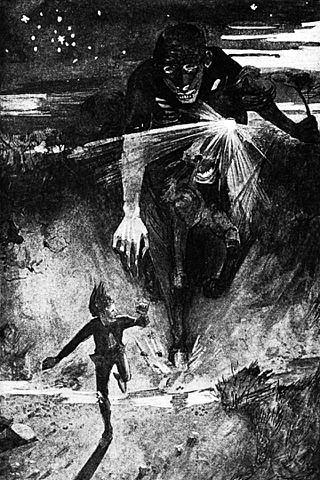
The nuckelavee or nuckalavee is a horse-like demon from Orcadian folklore that combines equine and human elements. British folklorist Katharine Briggs called it "the nastiest" of all the demons of Scotland's Northern Isles. The nuckelavee's breath was thought to wilt crops and sicken livestock, and the creature was held responsible for droughts and epidemics on land despite being predominantly a sea-dweller.
The Denham Tracts constitute a publication of a series of pamphlets and jottings on folklore, fifty-four in all, collected between 1846 and 1859 by Michael Aislabie Denham, a Yorkshire tradesman. Most of the original tracts were published with fifty copies. The tracts were later re-edited by James Hardy for the Folklore Society and imprinted in two volumes in 1892 and 1895. It is possible that J.R.R. Tolkien took the word hobbit from the list of fairies in the Denham Tracts.
The glaistig is a ghost from Scottish mythology, a type of fuath. It is also known as maighdean uaine, and may appear as a woman of beauty or monstrous mien, as a half-woman and half-goat similar to a faun or satyr, or in the shape of a goat. The lower goat half of her hybrid form is usually disguised by a long, flowing green robe or dress, and the woman often appears grey with long yellow hair.

The black dog is a supernatural, spectral, or demonic hellhound originating from English folklore that has also been seen throughout Europe and the Americas. It is usually unnaturally large with glowing red or yellow eyes, is often connected with the Devil, and is sometimes an omen of death. It is sometimes associated with electrical storms, and also with crossroads, barrows, places of execution and ancient pathways.
The Castle of Fiddes is a 16th-century tower house in Aberdeenshire, Scotland, located around 6 kilometres (3.7 mi) south-west of Stonehaven. It is dated 1592 on a window lintel, with a later date of 1673 on the east wall suggesting a renovation at this time. It was the property of the Arbuthnott family, who sold it in the later 17th century to the Thomson family of Arduthie. It was modernised around 1930 and remains occupied. It is a category A listed building.
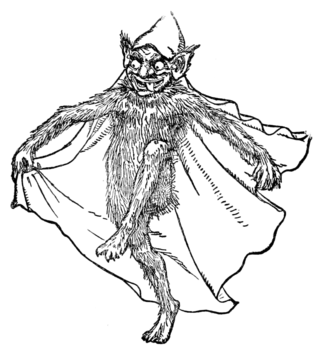
A goblin is a small, grotesque, monstrous creature that appears in the folklore of multiple European cultures. First attested in stories from the Middle Ages, they are ascribed conflicting abilities, temperaments, and appearances depending on the story and country of origin, ranging from mischievous household spirits to malicious, bestial thieves. They often have magical abilities similar to a fairy or demon, such as the ability to shapeshift.

The blue men of the Minch, also known as storm kelpies, are mythological creatures inhabiting the stretch of water between the northern Outer Hebrides and mainland Scotland, looking for sailors to drown and stricken boats to sink. They appear to be localised to the Minch and surrounding areas to the north and as far east as Wick, unknown in other parts of Scotland and without counterparts in the rest of the world.

The stoor worm, or Mester Stoor Worm, was a gigantic evil sea serpent of Orcadian folklore, capable of contaminating plants and destroying animals and humans with its putrid breath. It is probably an Orkney variant of the Norse Jörmungandr, also known as the Midgard Serpent, or world serpent, and has been described as a sea dragon.
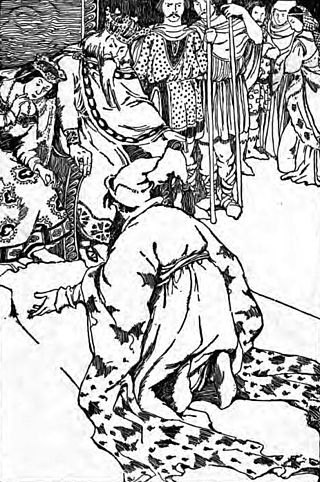
Assipattle and the Stoor Worm is an Orcadian folktale relating the battle between the eponymous hero and a gigantic sea serpent known as the stoor worm. The tale was preserved by 19th-century antiquarian Walter Traill Dennison, and retold by another Orcadian folklorist, Ernest Marwick, in a 20th-century version that integrates Dennison's texts with tidbits from other oral storytellers.
Jennifer Westwood was a British author, broadcaster and folklorist. She was a Doctor of Philosophy with special interests in English Language, Anglo-Saxon and Old Norse. Her first book, Mediaeval Tales, was published in 1968. An active committee member of The Folklore Society from 1987 until 2003, she undertook a variety of duties including editing its publications and helping other authors. As a broadcaster, she worked on programmes produced for BBC Radio 4 and the corporation's Radio Norfolk. Commonly known as "Jen", after her second marriage she also authored books in the name of Jennifer Chandler.

Ghostlore is an intricate web of traditional beliefs and folklore surrounding ghosts and hauntings. Ghostlore has ingrained itself in the cultural fabric of societies worldwide. Defined by narratives often featuring apparitions of the deceased, ghostlore stands as a universal phenomenon, with roots extending deeply into human history.
Fairy cup legends are folk and other tales usually relating to the theft of a "fairy cup", sometimes in the form of a drinking horn, usually from a "fairy mound". The legends are found in northwestern Europe.
The Black Penny, also known as the Hume-byres Penny, was a coin with medicinal properties mentioned in the "Remedies for Hydrophobia", a short folkloric tale included in the Denham Tracts.
References
- ↑ Westwood & Kingshill 2009, pp. 317–320.
- ↑ Westwood & Kingshill 2009, pp. 96–97.
- ↑ Farnie, Henry Brougham (1860), The Fife coast from Queensferry to Fifeness, pp. 112–3
- ↑ Westwood & Kingshill 2009, p. 317.
- ↑ Halliwell-Phillipps, James Orchard (1848), A Dictionary of Archaic & Provincial Words, Obsolete Phrases, Proverbs & Ancient Customs, Form the Fourteenth Century, vol. 2 (J-Z), p. 871, hdl:2027/hvd.32044100003607
- ↑ Hardy, James, ed. (1895), The Denham tracts : A Collection of Folklore by Michael Aislabie Denham, and reprinted from the original tracts and pamphlets printed by Mr. Denham between 1846 and 1859, vol. 2, Folklore Society, p. 79
Sources
- Westwood, Jennifer; Kingshill, Sophia (2009), The Lore of Scotland : A guide to Scottish legends
- Burness, John (1832), Thrummy Cap, a tale; and The Brownie O'Fearnden, a ballad
- Burness, John, The Comical Stories of Thrummy Cap and The Ghaist, Margaret and the Minister, Soda Water